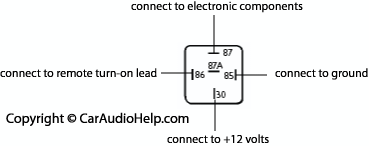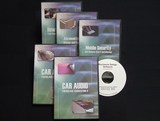Car Audio Electronic Components cont.
Diodes
|
LEDs
Light Emitting Diode |
An LED is a special diode which stands for light emitting diode. You're probably familiar with these as they are commonly used as turn on indicators for most electronic equipment. They come in various colors but the most common is red followed by green, yellow, and blue. Here is a picture of the common red LED. You'll notice that one of the leads is longer than the other. This is the anode. Keep in mind that LEDs operate on 1.8 volts so hooking them up to a twelve volt source will destroy them. I have been able to operate them off of a twelve volt source by using a common 1k ohm resistor in series with the anode. This drops the voltage enough to avoid damaging the LED. Any value between 600 and 1,200 ohms should work though. The lower value will make the LED brighter but may also shorten its usable life.
Relays
A relay is an electromechanical switch that is most widely used for car security systems. It is also commonly used as a way of protecting your head unit from damage if you have more than two devices (amplifiers, signal processors, etc.) being switched on by your head unit's remote turn-on lead. Basically a relay allows a small current to control a much larger current. The common Bosch type SPDT (Single Pole Double Throw) relay is show in the photo at right. A relay consists of four main parts. A copper coil, denoted by terminals 85 and 86, a common terminal, denoted by terminal 30, a normally closed terminal, labeled terminal 87a and a normally open terminal labeled terminal 87. Depending on whether your controlling voltage is negative or positive, terminal 85 or 86 will be either grounded or connected to +12 volts. If you have a positive controlling voltage, such as a head unit remote turn-on lead, you will need to ground either terminal 85 or 86. It doesn't matter which one you choose, but the other terminal will be connected to the remote turn-on lead of your head unit. The common lead, terminal 30, would be connected to +12 volts because that is what we want to apply to terminal 87 when the relay coil is energized. Terminal 87 would be connected to the remote turn-on terminals of our various electronic components (amplifiers, crossovers, equalizers, etc.). Here is an illustration of how we would wire up our example. When our remote turn-on lead applies +12 volts to the relay, the coil becomes energized and connects terminal 30 to terminal 87. We could have also connected terminal 30 to the electronic components and terminal 87 to +12 volts. Either way would give us the results we're looking for. |
 |
| Relay Wiring Schematic for a Remote Turn On Lead |
Free Newsletter
Newsletter Archives
![]()
![]()
Car Audio Training DVDs
![]() Complete DVD Special
Complete DVD Special
Car Stereo Installation
Car Alarm Installation
Advanced Enclosures
Fiberglass Fabrication
Fiberglass Fabrication II
![]()
![]()



